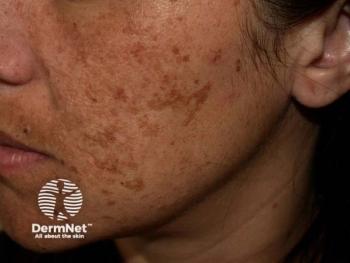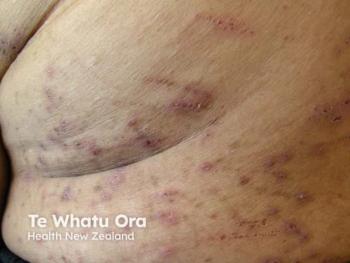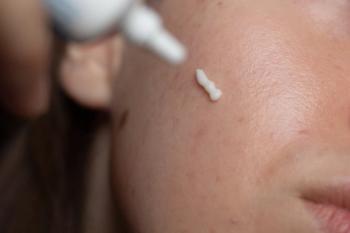
Liza O’Dowd, MD, Discusses What Sets Icotrokinra Apart in Psoriasis Treatment Following NDA Submission
Key Takeaways
- Icotrokinra, an oral IL-23 receptor antagonist, shows biologic-like efficacy and safety in phase 3 trials for plaque psoriasis.
- The drug demonstrated superiority over deucravacitinib and potential parity with injectables like ustekinumab.
O'Dowd discusses J&J's recent NDA submission for icotrokinra in psoriasis.
Johnson & Johnson recently announced the submission of a New Drug Application to the US FDA for icotrokinra, an investigational, first-in-class oral IL-23 receptor antagonist peptide for adults with moderate to severe plaque psoriasis.1
The submission is supported by data from the ICONIC phase 3 program, including the ICONIC-LEAD, ICONIC-TOTAL, and ICONIC-ADVANCE studies, which demonstrated efficacy, safety, and superiority over an active comparator.2-4
Dermatology Times spoke with Liza O’Dowd, MD, vice president and disease area leader for immunodermatology and respiratory at Johnson & Johnson Innovative Medicine, about icotrokinra’s mechanism of action, promising clinical trial results, and what sets it apart in the psoriasis landscape.
Q&A
Dermatology Times: Icotrokinra represents the first oral peptide targeting the IL-23 receptor. How does this mechanism of action differ from current oral and biologic treatments for moderate to severe plaque psoriasis, and why is this approach significant?
O’Dowd: Current available treatment options for plaque psoriasis fall into 2 major buckets. The first are the injectables, so those are, as available today, monoclonal antibodies that target cytokines. Then there are also other approaches, which are other oral approaches, that are also available in the marketplace.
What's unique around about icotrokinra, and what we're really proud of, is the oral peptide approach. This specifically targets the IL-23 receptor, and as a peptide, it very exquisitely, in a sort of a lock and key mechanism, is targeting the receptor, so it gives us the opportunity to deliver biologic-like activity by blocking the receptor through a very targeted oral approach. This will, of course, limit any safety or tolerability issues to specifically blocking the receptor, so we're not going to get any off-target effects.
Dermatology Times: What did the phase 3 ICONIC program show in terms of efficacy and safety?
O'Dowd: This is a very, very comprehensive program that we developed to support the registration of ictrokinra, and there's a number of things that I think are worth calling out.
The first is that we've had, as I mentioned, a biologic-like benefit in terms of efficacy. For example, in our ICONIC-LEAD trial, which we've previously shared at medical conferences, we showed that patients achieved quite high levels of total skin clearance by week 24—really in the range that we see with the injectables. That's really important for patients, because we are offering the opportunity to have skin clearance at that very, very high level of efficacy through an oral mechanism.
We also have data looking at special skin areas. These are areas that are traditionally quite hard to treat for for patients with psoriasis and have a very hard, large impact on their quality of life. Think about having plaque psoriasis in your palms, your soles, in your generals, or in your scalp, so really quite disturbing for patients to have to struggle with that. In these special areas, specifically calling out the scalp in general, we have very high levels of near total skin clearance at week 24, as well, in the 66 to 75% range.
Then we have announced that we have also shown superiority to one of the other orals already on the marketplace, deucravacitinib, and we have demonstrated superiority against deucravacitinib on all the primary and secondary endpoints that have been evaluated. Details of that will, of course, be shared in upcoming medical meetings.
The other point around the icotrokinra program is that we did include adolescents as part as our phase 3 program. We're going to be able to, if approved, offer this medicine to kids in that 12 to 18 range at launch. We also demonstrated very, very high levels of skin clearance in that patient population, as well.
Then finally, the last piece of our puzzle will be head-to-head data that we're generating versus a biologic. We will have the results of that study available over the next period of time before launch. This is the first time a pill has taken on a biologic with the purpose of showing superiority of a pill versus a systemic injectable. In this case, we're studying it against Stelara, or ustekinumab.
Dermatology Times: Head-to-head data from ICONIC-ADVANCE 1 & 2 demonstrated superiority to deucravacitinib. What do these results suggest about the potential positioning of icotrokinra in the treatment landscape?
O’Dowd: I think for prescribers and for patients to understand their choices, we know that we have data from a study that we ran called ENCOMPASS, which gave us the insights that up to 91% of patients on an injectable would actually like the option to switch to an oral, but in doing that, they need to know that what they're going to get is tolerable, safe, and effective. These results check off a couple of boxes in the sense that we've been able to demonstrate very, very high efficacy that is better than currently-available orals. Hopefully, our data versus ustekinumab will not surprise us and continue to demonstrate that it is better than other injectables on the market, and continue to show that it's on par with the data that we have showing that similar efficacy to the injectables.
When you think about all this and you bring it together for patients who want a choice, this really gives an opportunity of not having to make that trade off between, "Well, I have a pill that maybe works, but maybe doesn't work," because the efficacy may not really be where you can be with an injectable. Or, "Do I go to an injectable? But then I have to use a needle," or they prefer not to have to take that last step to an injectable.
With these data in hand, I think physicians can have real conversations with their patients around another alternative, which would give patients an opportunity to get what we call a trifecta approach of having the choice of an oral that is both efficacious with a well-established safety profile. That's what we think it means for patients. It gives them a real, important choice, which we think can be a game changer for the field, and having a new option that checks off all those boxes.
Dermatology Times: What else is important for clinicians to know about icotrokinra for psoriasis?
O’Dowd: I'm going to take it back to the patient. The reason we develop medicines like this is because the unmet need in psoriasis is so high. Let's not forget how many patients suffer with moderate to severe psoriasis, how many patients suffer from psoriasis in general, and how many of those patients are not getting advanced therapies, even though they meet all the criteria for moderate to severe disease. They're suffering with the painful, itchy, uncomfortable skin. They have the thick plaques, all these things, and they're slathering on topical creams and everything else, and they're just not getting relief, and they're not getting the advanced therapies. We're really hoping that, if approved, this will give patients a really meaningful treatment option that gives them a choice of biologic-like efficacy with a wonderful safety profile and a once daily pill. I think that is really important for the physicians and patients to have a real choice, and that will open the door for more patients who may not get access for a lot of different reasons, to choose to access this drug or others that may come behind it to help treat their disease.
That's really what it's about for us. We really want to make a difference for those patients, and if we can, provide another way for them to get that really high bar of efficacy with an acceptable safety profile. If approved, I think this is a breakthrough for the field.
We are not done with dermatology with this asset. There are many patients suffering from other severe immunological dermatology conditions that really need alternative treatment approaches. This is the next step in our journey to trying to address those unmet needs for those patients and other diseases that need to be tackled, like atopic dermatitis and more. This is part of our journey. and we hope that we can successfully bring this one through to approval to impact those patients in a really meaningful way.
References
- Johnson & Johnson seeks first icotrokinra US FDA approval aiming to revolutionize treatment paradigm for adults and adolescents with plaque psoriasis. News release. Johnson & Johnson. July 21, 2025. Accessed July 29, 2025.
https://www.jnj.com/media-center/press-releases/johnson-johnson-seeks-first-icotrokinra-u-s-fda-approval-aiming-to-revolutionize-treatment-paradigm-for-adults-and-adolescents-with-plaque-psoriasis - A study of JNJ-77242113 in participants with moderate to severe plaque psoriasis (ICONIC-ADVANCE 1). ClinicalTrials.gov. Identifier: NCT06143878. Updated February 26, 2024. Accessed July 29, 2025.
https://clinicaltrials.gov/study/NCT06143878 - A study of JNJ-77242113 in participants with moderate to severe plaque psoriasis (ICONIC-ADVANCE 2). ClinicalTrials.gov. Identifier: NCT06220604. Updated February 26, 2024. Accessed July 29, 2025.
https://clinicaltrials.gov/study/NCT06220604 - A study of JNJ-77242113 in adolescent and adult participants with moderate to severe plaque psoriasis (ICONIC-LEAD). ClinicalTrials.gov. Updated April 2, 2025. Accessed July 29, 2025.
https://clinicaltrials.gov/study/NCT06095115
Newsletter
Like what you’re reading? Subscribe to Dermatology Times for weekly updates on therapies, innovations, and real-world practice tips.


















